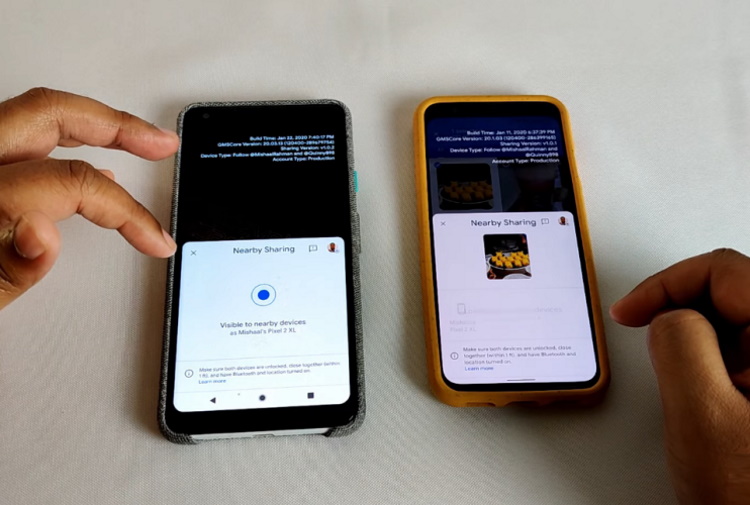

- HOW TO USE GOOGLE NEARBY SHARE HOW TO
- HOW TO USE GOOGLE NEARBY SHARE WINDOWS 10
- HOW TO USE GOOGLE NEARBY SHARE ANDROID
- HOW TO USE GOOGLE NEARBY SHARE PRO
- HOW TO USE GOOGLE NEARBY SHARE PC
HOW TO USE GOOGLE NEARBY SHARE ANDROID
Remember that your Android device's location, Wi-Fi, and Bluetooth must be on for Nearby Share to work. Nearby Share is rolling out to Android 6. Nearby Share is available on almost all Android 6.0 or newer devices. In such cases, you can use Snapdrop to transfer files between Linux, Android, and iOS. Nearby Share is not available for iOS or Linux. While Nearby Share works offline, it might use mobile data to transfer files between devices in some cases. It achieves this by using a mix of Bluetooth, Bluetooth Low Energy, WebRTC, and Wi-Fi Direct. Nearby Share removes all the pain points of Bluetooth or Wi-Fi direct file transfer by simplifying the pairing process and transferring large files in a jiffy. Go to 'Devices & Sharing.' Select 'Nearby Share.' First, make sure 'Use Nearby Share' is toggled on at the top of the screen. Nearby Share can also be used to quickly transfer files to and from Chromebooks. Nearby Share is currently in beta but works well. Step 2: Set up Nearby Share on your Windows PC.
HOW TO USE GOOGLE NEARBY SHARE PRO
Apart from files and photos, you can use Nearby Share to transfer installed apps between Android devices as well. Pro tip: If you plan to use Nearby Share frequently, you can add it to your Quick Settings menu for easy access. The feature will seamlessly let you transfer files, documents, links, and more with other nearby Android devices in just a few taps. We hope that Google fixes the issue and brings faster file sharing - no matter whether the device is connected to an access point or not.Nearby Share is Google's take on AirDrop for Android. Transfer Speed when NOT connected to a WiFi NetworkĪs we went through the article, it’s clear that the Nearby Share algorithm is unable to determine the right protocol for file sharing, especially when devices are connected to a WiFi network. Transfer Speed when connected to a WiFi Network Frequently, you get slower transfer speed and that makes file sharing through Nearby Share infuriating, to say the least.
HOW TO USE GOOGLE NEARBY SHARE WINDOWS 10
There are times when it correctly chooses the WiFi Direct protocol but the chances are very slim. Windows 11 Windows 10 Nearby sharing in Windows lets you share documents, photos, links to websites, and more with nearby devices by using Bluetooth or Wi-Fi. It goes on to show that Nearby Share’s algorithm is not fine-tuned to pick the right protocol and often, it picks the wrong ones to transfer files. However, when you are connected to a WiFi Network, it seems Nearby Share is choosing WebRTC or Bluetooth protocol which results in a much slower transfer. Here, peer-to-peer WiFi (WiFi Direct) is the fastest way to transfer files and when you are not connected to an access point, WiFi Direct is used. Google in its blog states that “Nearby Share automatically chooses the best protocol for fast and easy sharing using Bluetooth, Bluetooth Low Energy, WebRTC or peer-to-peer WiFi”. So what explains this weird behavior? I think the problem lies in the algorithm that determines the protocol for file sharing. So it’s clear that Nearby Share is pretty capable but due to some unknown reasons, the speed remains slow when devices are connected to a WiFi network.
HOW TO USE GOOGLE NEARBY SHARE HOW TO
Open your Settings app and tap Google > Devices and sharing > Nearby Share. How to Use Nearby Share to Send Files From Android to Windows After you have set up the Nearby Share app on your PC, you can start receiving files from your Android phone. In true essence, Nearby Share’s performance is far better than Mi Share, Snapdrop, and much closer to the gold-standard, AirDrop. Make sure that Bluetooth and location are turned on. Basically, when you are not connected to a WiFi network, you are getting around 10 times more transfer speed. The transfer speed roughly translates to 23MBps. To give you a number, it just took 9 seconds for Nearby Share to transfer a video file of 205MB in size.

Step 3: Enable the Nearby Share toggle at the top. Step 2: Choose Devices and sharing and then tap on Nearby Share. Step 1: On your Android device, go to Settings and then Google. Method 1: Turn on Nearby Share via Google App. Surprisingly, when both the devices are not connected to a WiFi access point, you will find that Nearby Share just flies through and transfers the files much quickly. First of all, if you want to share files with Nearby Share, you need to set up and enable Nearby Share. Now, according to a recent report from Techdows, Nearby Shares UI is now showing up in Google Chrome on Windows on the Chrome Dev and Canary channels. Learn how to unlock the power of efficient file sharing. Sending files to your own devices is even faster. Googles Nearby Share takes file sharing to the next level with its latest update. Just select which Android devices you want to share with from the list that pops up.
HOW TO USE GOOGLE NEARBY SHARE PC
Nearby Share is actually not slow and you discover that when you are not connected to a WiFi network. Sending a photo, video or document from your PC to a nearby Android device is as easy as dragging and dropping it into the app, or by selecting Send with Nearby Share in the right-click menu.


 0 kommentar(er)
0 kommentar(er)
